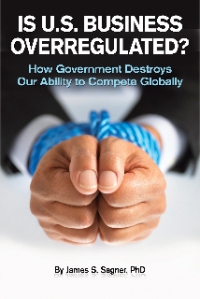 Our last blog discussed three areas of likely political and regulatory change as the result of the financial crisis of 2007-2008. Here are four more areas for change.
Our last blog discussed three areas of likely political and regulatory change as the result of the financial crisis of 2007-2008. Here are four more areas for change.
4. The Organization of Regulation. Although functional regulation continues in the financial industries, the passage of deregulation through GLB permits financial companies to enter any financial area. This situation of inadequate oversight may have been a major element in the 2008 credit crisis and strongly suggests the need for consideration of a consolidated regulatory scheme similar to that used by the Financial Services Authority in the U.K. (For a more complete discussion, see James Sagner, Is U.S. Business Overregulated? How Government Destroys Our Ability to Compete Globally, York House Press, 2008, particularly Chapter 7.) The matching of the integrated strategy permitted by GLB to an appropriate regulatory structure has been suggested by Secretary of the Treasury Henry Paulson and others, and is likely to be considered in the next Congress as omissions and errors made both by the regulators and the companies are investigated.
5. Government Market Actions. The theory of a free market clearing supply and demand at an equilibrium price may not be working in certain situations, and governments will not stand back and watch chaos and instability destroy long-established consumer expectations and behaviors. The most obvious recent problem has been with commodities, from metals to energy to food, although the precise role of speculators and hoarders has yet to be definitively established. In any event, governments will stockpile, subsidize, set price floors and ceilings, prosecute and change the procedures by which these products trade.
6. Restrictions on Business. Congress is loath is interfere with the free market system and realizes that it knows less than business managers how companies should operate. (Most Congressmen have never worked in the corporate world; for statistics on the professions of the current Congress, see “Membership of the 109th Congress: A Profile,” CRS Report for Congress, pages CRS 3-4, at www.senate.gov/reference/resources/pdf/RS22007.pdf). The disastrous post-World War II experience in Great Britain with nationalization ended with Prime Minister Thatcher’s decision to privatize most of British industry, and we are not about to go back to the days of a Labour Party under Prime Minister Clement Atlee. However, there is considerable pressure on executive pay, particularly regarding disclosure and limitations.
It is possible that many companies could be subject to new rules as the asset-purchasing program of the U.S. Department of the Treasury begins. Executive pay is affected in several ways, including limitations on tax-deductible compensation (now $500,000). Board committees that approve executive compensation may be required to examine the risks a senior manager might be motivated to take on to meet his/her goals. Members of Congress have indicated that the current financial rescue package approach to compensation could be extended to all publicly-traded companies.
7. Government Senior Administratorship. One of the most unfortunate outcomes from this entire credit market disaster has been the growing recognition of the weak stewardship at certain of the regulatory agencies that should have been monitoring the situation. The country does have two strong leaders in Chairman Bernanke at the Federal Reserve and Secretary Paulson at the Treasury. Congress may begin to realize that awarding senior-level jobs to former colleagues, the relatives of former cabinet secretaries, or other political hacks is a poor method to choose Executive Branch senior managers.
Just as some states write qualifications for cabinet-level positions, the Congress may choose to insist on banking, accounting, legal or other relevant agency-specific experience for these critical positions. Furthermore, the old tradition of rewarding cronies who were defeated in a recent election must be very carefully examined; the voters probably knew what they were doing, and the framers of the Constitution never intended the Senate to be a rubber stamp in approving jobs for the pals of the President.
Filed under: economics | Tagged: Ben Bernanke, cronism, Department of Treasury, Executive Branch, executive pay, Federal Reserve, government market actions, regulation, report for congress, Secretary Paulson, tax-deductible compensation, the organization of regulation, theory of free market | Leave a comment »


